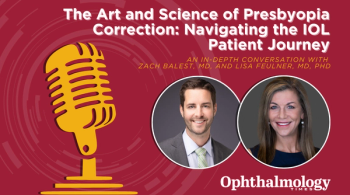
- Ophthalmology Times: November 1, 2020
- Volume 45
- Issue 18
Investigators study home-based monitoring for exudative AMD
Novel OCT system with AI-based image analysis holds promise.
This article was reviewed by Judy E. Kim, MD
A deep learning artificial intelligence (AI) algorithm for the automated analysis of images from a home-based
“Currently, much of our diagnosis and management of eyes with exudative AMD is dependent on OCT,” she said. “At-home diagnostic testing, such as home[-based] OCT, offers [the] opportunity for personalizing disease management by providing inter-visit information that allows us to catch progression or recurrence as soon as it happens. As a result, we may be able to reduce both the likelihood of undertreating and the treatment burden while maintaining visual acuity during treatment.”
Related:
Kim, a professor of ophthalmology at the Medical College of Wisconsin in Milwaukee, noted that the investigational
“We believe the system has the potential to accurately monitor AMD disease activity in a self-operated home environment, which would be a paradigm shift in patient management,” she said. “Use of this system might also give us new insights into the markers of
Related:
System description
Both the home OCT device (Home OCT, Notal Vision) and deep learning algorithm (Notal OCT Analyzer) are investigational in the United States.
The device is a compact SD-OCT unit that can be self-operated by patients. It takes cross-sectional images of the central 10º (3 x 3 mm) of the macula and generates 88 B-scans with dense, 34-µm spacing.
The images are uploaded to the cloud for automated analysis by the AI-based algorithm, which was developed to detect and quantify retinal fluid in exudative AMD and to follow the volume quantities over time.
In addition to images generated by the home-based OCT device, it can analyze images acquired with commercially available SD-OCT platforms (Cirrus, Carl Zeiss Meditec; Spectralis, Heidelberg Engineering).
The analyzer automatically segments the OCT images, then identifies and quantifies subretinal fluid (SRF) and intraretinal fluid (IRF). The fluid status report generated by the system includes a fluid thickness map that shows the distribution and location of fluid and fluid volume tracking over time.
Related:
Accuracy testing
The performance of the deep learning algorithm for identifying and quantifying retinal fluid from the home
The eyes were randomly split 8:1 into learning and validation data sets. From each volume scan of 88 images, about 10 B-scans were selected for manual segmentation, each labeled pixel-wise into 4 compartments (vitreous/outer layers, retina, SRF, IRF).
A total of 3428 B-scans, of which 75% had fluid, were manually segmented. The performance of the deep learning algorithm for the quantification of B-scan segmented fluid was evaluated by comparison to determinations of a human grader, and the results showed excellent agreement (Pearson correlation coefficients = 0.98 for SRF and 0.90 for IRF).
Related:
Pixel-wise fluid was compared with recall/precision. The SRF fluid pixel-wise recall was 0.72 and precision was 0.86; the IRF recall was 0.80 and the precision was 0.77.
The system also demonstrated excellent accuracy for detecting SRF and IRF in the B-scans with sensitivity and specificity of 0.99 and 0.98, respectively, for SRF and 0.99 and 0.97, respectively, for IRF.
Case study
In her presentation, Kim illustrated the use of the home-based OCT system for monitoring a patient undergoing anti-VEGF therapy for
Kim presented reports from images obtained over a period of 42 days from a patient who, on an earlier visit, had received an anti-VEGF injection. At baseline, the algorithm detected 18 picoliters of fluid in the subretinal space, which was barely visible to the physician.
Related:
The fluid volume increased to 18 nL on day 20 and more dramatically to 124 nL within the next 4 days. The patient received an intravitreous injection of an anti-VEGF agent on day 24. The fluid volume decreased to 45 nL on day 28 and to just 2.8 nL on day 42.
“Marked improvement after the [intravitreous] injection was demonstrated on the fluid map as well as in the longitudinal fluid volume graph,” Kim concluded. “The artificial intelligence-based analysis of OCT images provides new insights into temporal retinal fluid dynamics.”
--
Judy E. Kim, MD
e:[email protected]
Kim receives research support from and is on the advisory board for Notal Vision.
Articles in this issue
almost 5 years ago
Ocular gene therapy offers hope for inherited retinal diseaseabout 5 years ago
Good nutrition optimizes ocular surface in premium cataract patientsabout 5 years ago
Extended depth-of-field IOLs: Clarifying current nomenclatureabout 5 years ago
Investigators show long-term visual declines in DME eyesabout 5 years ago
Developing retinal technologies strengthen visualizationabout 5 years ago
Building a brand is key to developing successful practiceabout 5 years ago
Changing patient conversations around cataract surgeryabout 5 years ago
Planning is important — even when “nobody knows nothing”Newsletter
Don’t miss out—get Ophthalmology Times updates on the latest clinical advancements and expert interviews, straight to your inbox.













































.png)


